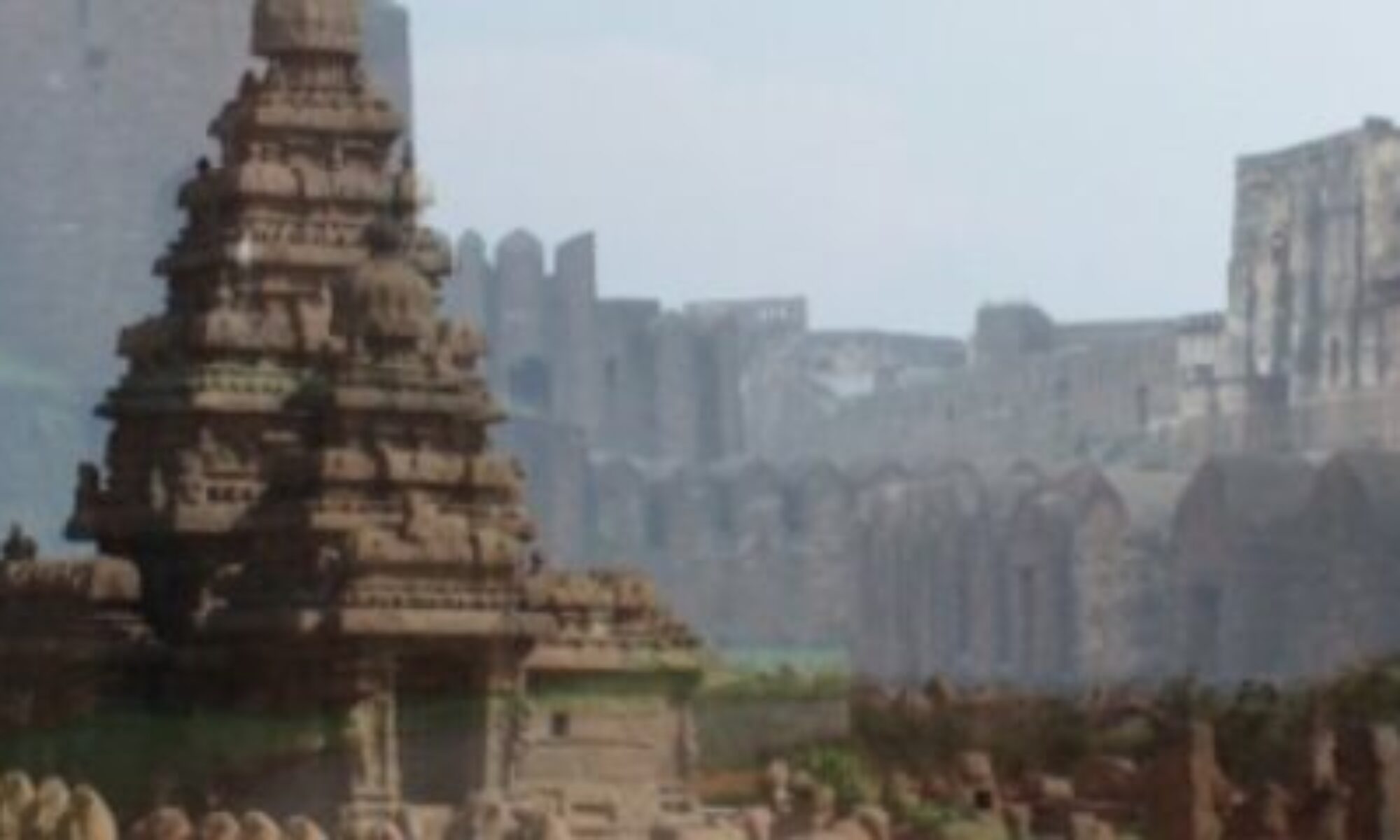The Buddhist temples come to an end and we start with the Brahmanical series excavated between the seventh and ninth centuries. Here are glimpses of a world apart from the Chaityagrihas and Viharas. The familiar Buddhas and Bodhisattvas are gone. The motifs are still as religious as the Buddhist art, but the representations take other forms. The imagination and poetry of a new concept was reflected in art which att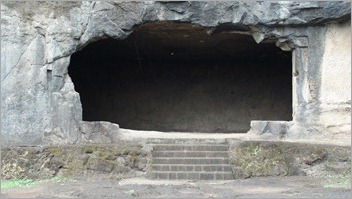 ained a new visual grace and power. It is important to note that this revival which produced this group of caves under royal patronage had nothing in it of intolerance against the Buddhist system. The sacred duty of the king as defender of faith was to give protection to all religious devotees and few of them failed in their duty in this respect.
ained a new visual grace and power. It is important to note that this revival which produced this group of caves under royal patronage had nothing in it of intolerance against the Buddhist system. The sacred duty of the king as defender of faith was to give protection to all religious devotees and few of them failed in their duty in this respect.
Cave 13 is to the left of the Tin Taal, is a large perfectly plain room. The front has been destroyed by the decay of the rock. It may have been sort of a rest house for visitors.
Cave 14 (Ravana Ki Kai): Close to the last, which doubtless belonged to it, is an early Brahmanical Cave, with four pillars in front and twelve inside the open hall, all of them more or less carved. The hall measure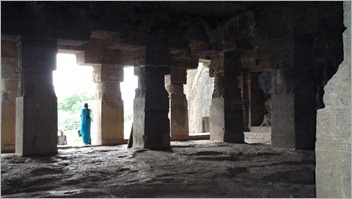 s 54 feet in length and 55 feet deep to the front of the shrine. The shrine is surrounded by a pradakshinapatha or circumambulation making the total depth of the excavation 85 feet. The central shrine is 15 feet in height and the side aisles 14 feet.
s 54 feet in length and 55 feet deep to the front of the shrine. The shrine is surrounded by a pradakshinapatha or circumambulation making the total depth of the excavation 85 feet. The central shrine is 15 feet in height and the side aisles 14 feet.
Two pillars in front and one in the front aisle are gone. They have high square bases and drooping florid capitals with circular necks of various patterns. The south wall is covered with Saiva sculptures. They are
a) Mahishasura Mardhini – A Form of Parvati killing the buffalo demon.
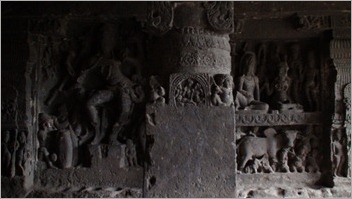 b) Siva and Parvati on a raised platform playing a dice game. Ganapati and an other attendant wait behind Siva, and two females and a male behind Parvati, while between, but beyond them, Bhringi looks on at the game. Five of the faces in this compartment have been badly hacked in the 17th century, Below is Nandi, the vehicle of Siva, and thirteen fat dwarfs.
b) Siva and Parvati on a raised platform playing a dice game. Ganapati and an other attendant wait behind Siva, and two females and a male behind Parvati, while between, but beyond them, Bhringi looks on at the game. Five of the faces in this compartment have been badly hacked in the 17th century, Below is Nandi, the vehicle of Siva, and thirteen fat dwarfs.
c) Siva dancing the tandava, or the great dance which 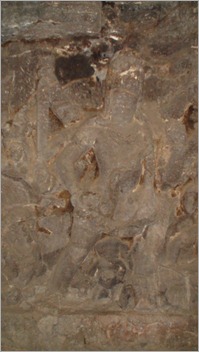 he performs over the destruction of the world.; three figures with drums are to his right. Bhringi, his skeleton assistant, is behind, and Parvati and two dwarfs – one with a cat face – are on his left. Above are Brahma and Vishnu on this left, Indra on his elephant on his right with Agni on his ram and two others.
he performs over the destruction of the world.; three figures with drums are to his right. Bhringi, his skeleton assistant, is behind, and Parvati and two dwarfs – one with a cat face – are on his left. Above are Brahma and Vishnu on this left, Indra on his elephant on his right with Agni on his ram and two others.
d) Now we come to the sculpture which has give this cave the name. Ravana, the demon king, proud of his immeasurable strength, got under Kailasa and intended to carry it off. Parvati got alarmed and feeling the place shake, clung to Siva who pressed his foot down to fix Ravana under the hill until he repented of his misdeed. Ravana had ten heads and twenty arms, and often on the top of his cap, an animals head is represented, some say that of an ass. 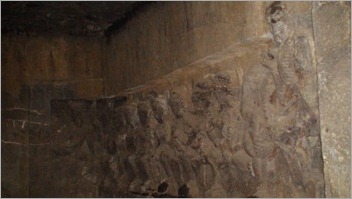 Four dwarfs here mock him. Siva and Parvati have two attendants on their side.
Four dwarfs here mock him. Siva and Parvati have two attendants on their side.
e) Bhairava, the destructive form of Siva, his foot on a large fat dwarf, another at his side, Ganapati behind him holding up with two of his hands, the elephant-hide in which he wraps himself; with other two he holds a spear with which he transfixed Ratnasura; in one a long sword, and in the sixth a bowl to receive the blood of his v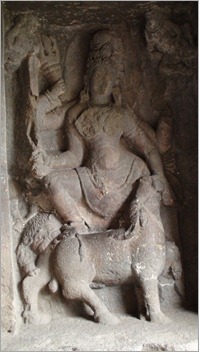 ictim
ictim
f) The pradakshinapatha on this side has a remarkable group. The first portion totally dark consists of three skeletons. Kal, four armed with a scorpion on his breast, Kali the female personification of death, and a third kneeling. There comes Ganapati eating his laddoos, beyond whom are the seven divine mothers, four armed and each with a child. On the return of the wall at the back is Siva seated with the axe and his small hand drum (damru).
On the left wall commencing from the front are:
a) Bhavani or Durga, four armed, with her foot resting on her tiger, holding her tris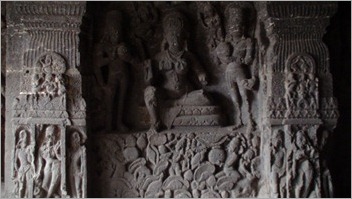 ula or trident in her upper right hand; the others are broken.
ula or trident in her upper right hand; the others are broken.
b) Lakshmi, the wife of Vishnu, over a mass of lotuses, with figures holding up water jars, and a tortoise among them. She has two arms, but her attendants have four. She holds a Sankha and Chakra and elephants bathe her with water from jars.
c) Varaha, th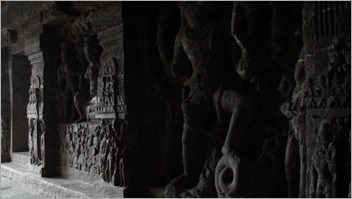 e boar incarnation of Vishnu, his foot on Sesha the great serpent, holding up Prithivi, the personification of Earth. A Snake demon is between his feet, and figures with snake hoods stand on each side
e boar incarnation of Vishnu, his foot on Sesha the great serpent, holding up Prithivi, the personification of Earth. A Snake demon is between his feet, and figures with snake hoods stand on each side
d) Vishnu, four armed sits in Vaikunta along with his consorts Lakshmi and Sita, and four attendants behind with chauris. Below is his vehicle, Garuda the man-eagle. Also are several other males and females, some of them playing musical instruments.
e) Vishnu and Lakshmi seated on the same couch under an 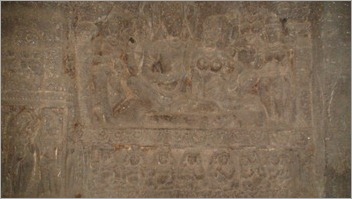 ornamental arch, with attendants behind. Below are seven dwarfs, four of them playing musical instruments.
ornamental arch, with attendants behind. Below are seven dwarfs, four of them playing musical instruments.
The front of the shrine has two very large male dvarapalas and a number of other figures. Inside the shrine is an altar against the back wall, and a broken image of Bhavani or Durga, to whom this cave temple was unmistakably dedicated. There are four holes, as if for fire pits on the floor of the hall.
We now proceed to one of the most important caves in Ellora, the Dasavatara Cave.
